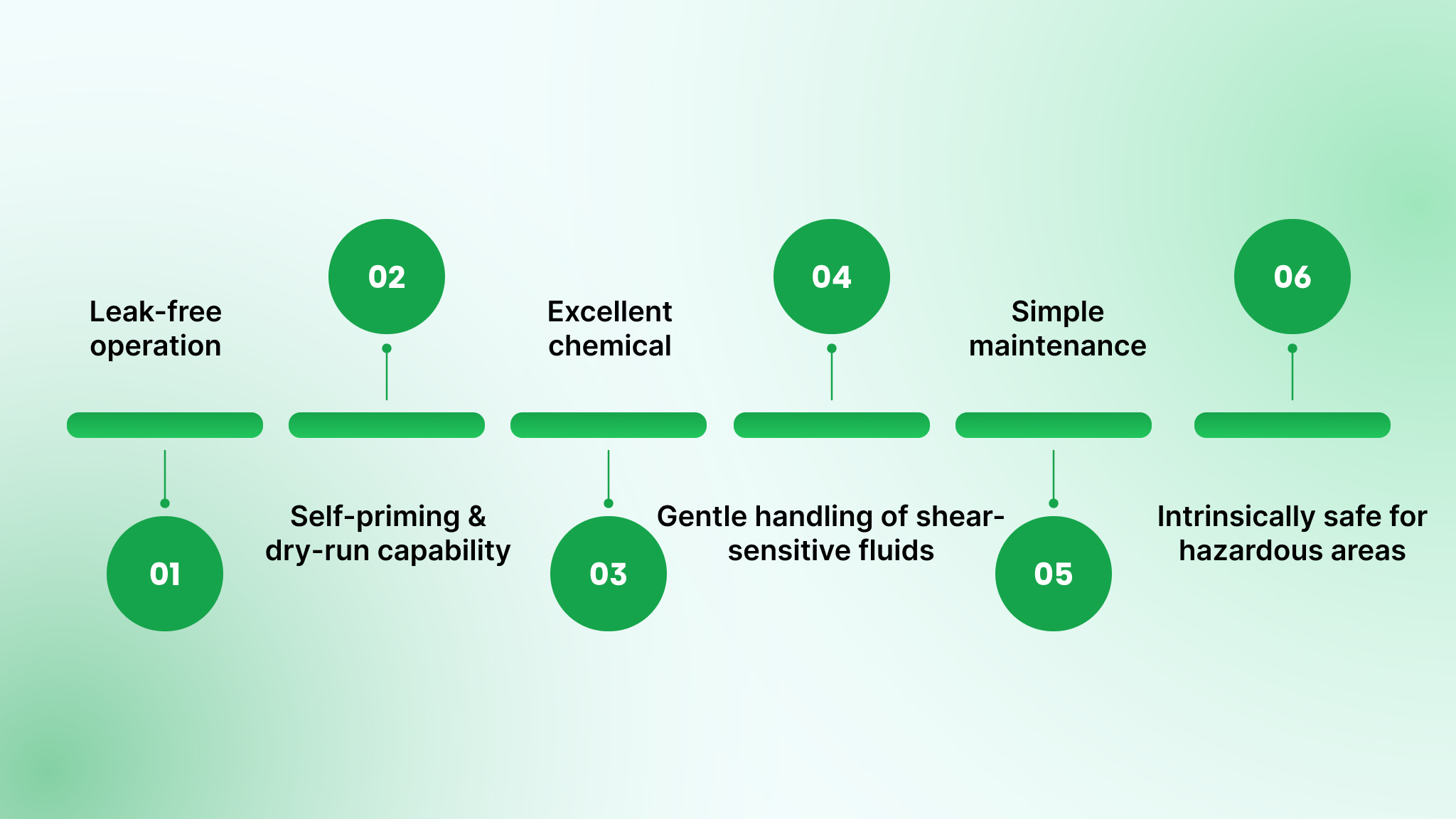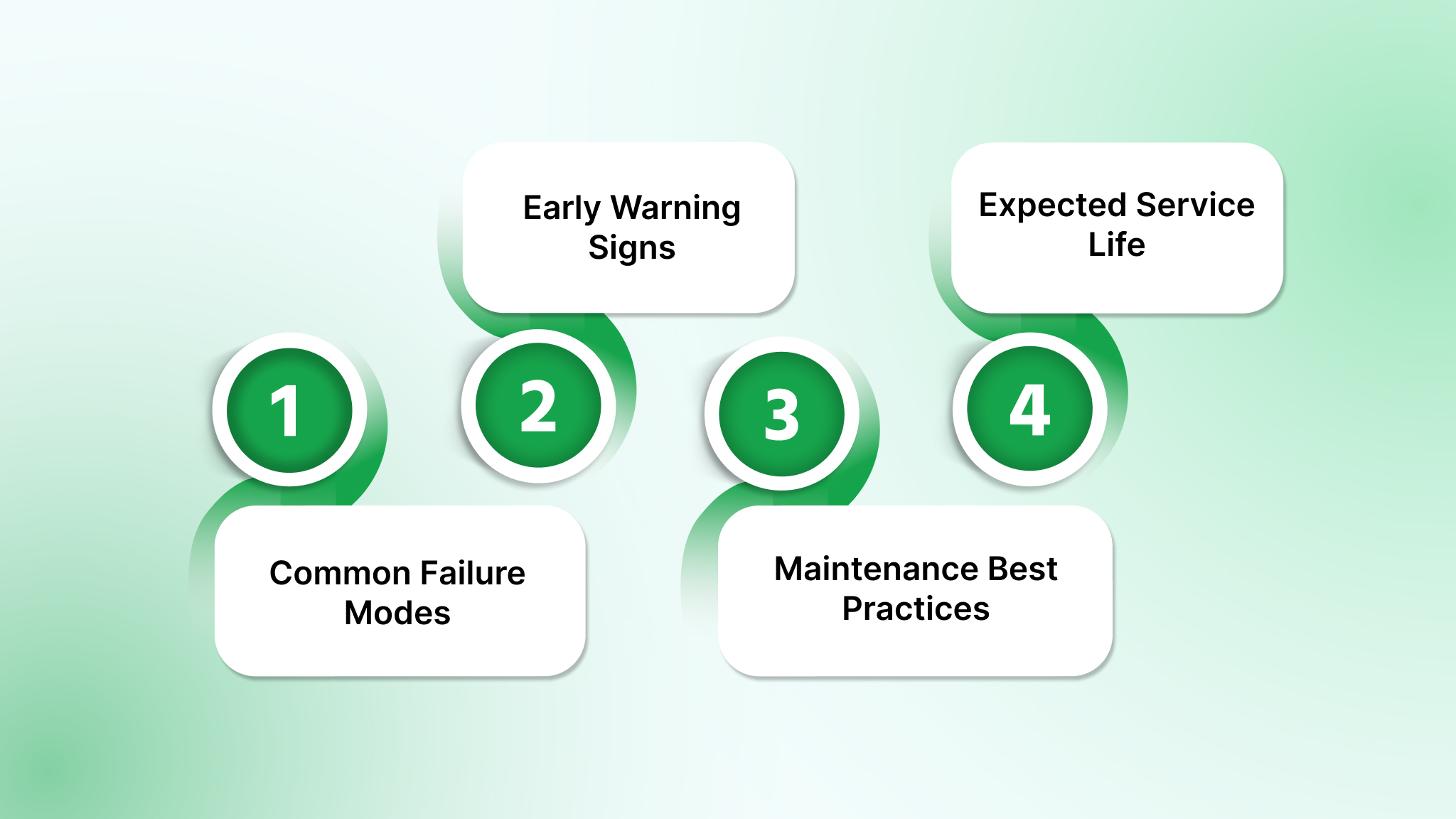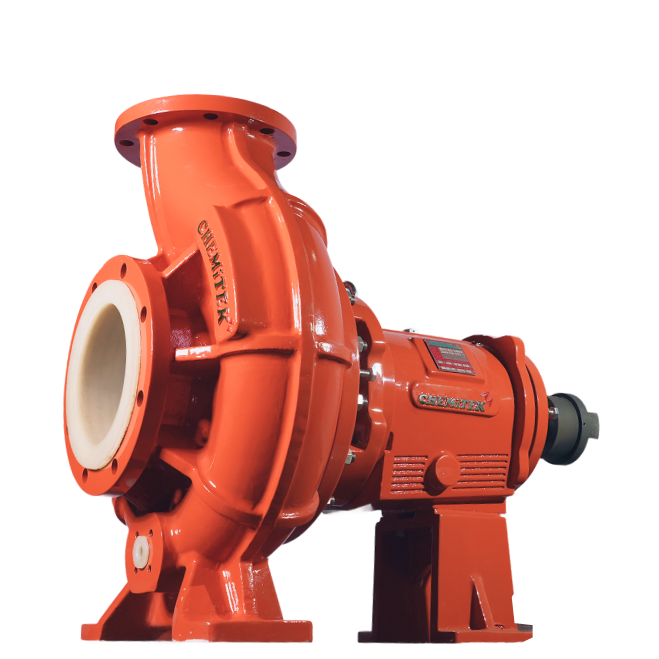In industrial fluid handling, choosing the right pump is not just about flow rate; it’s about long-term reliability, maintenance predictability, and process safety. Diaphragm pumps, a type of positive displacement pump, are often selected for their leak-free operation and ability to handle corrosive, abrasive, or viscous fluids.
They are widely used in chemical processing, wastewater treatment, pharmaceuticals, and food manufacturing, where containment and precision matter more than raw throughput.
However, diaphragm pumps come with their own set of performance limits. Their flow output is typically lower than centrifugal designs, their pressure and temperature ratings depend heavily on diaphragm material, and they introduce pulsation that can affect downstream systems if not properly managed.
For engineers comparing alternatives, understanding these trade-offs is essential to avoid mismatched installations that lead to inefficiency, premature wear, or downtime.
This article offers a data-driven examination of the advantages and disadvantages of diaphragm pumps, supported by quantitative performance ranges and practical maintenance insights. It also highlights where diaphragm pumps perform best and where other pump configurations may be better suited for industrial duty.
Key Takeaways:
- Diaphragm pumps provide reliable, leak-free operation, making them suitable for handling corrosive, abrasive, or toxic fluids.
- They can self-prime and tolerate dry running or air pockets without mechanical damage.
- Their performance is limited by flow, pressure, and temperature, typically below 100 L/min, 8 bar, and 120 °C, making them unsuitable for continuous high-flow or high-temperature service.
- Air-operated models consume more energy and produce pulsation that often requires dampening equipment for stable operation.
- They are best applied in dosing, transfer, or intermittent-duty processes rather than continuous 24×7 industrial flow lines.
How Diaphragm Pumps Work
A diaphragm pump operates by flexing a diaphragm back and forth to increase and decrease the volume of a sealed chamber alternately. During the suction stroke, the diaphragm retracts, creating a vacuum that draws fluid in through a one-way inlet valve.
When the diaphragm moves forward, it compresses the fluid and pushes it out through an outlet check valve. Because the process fluid is fully contained within the chamber and separated from the drive mechanism, there is no need for dynamic shaft seals, eliminating the risk of leakage.
Diaphragm pumps can be driven either pneumatically (air-operated double-diaphragm, AODD) or mechanically via an electric motor and crank mechanism.
Their positive displacement design makes them inherently self-priming and capable of handling gases, slurries, and viscous liquids, though with natural pulsation in the discharge flow due to their reciprocating motion.
Advantages of Diaphragm Pumps
Diaphragm pumps offer several operational benefits that make them indispensable across chemical, pharmaceutical, and water treatment processes. Below are the key engineering advantages that define their value in industrial applications.

1. Leak-free operation
Diaphragm pumps separate the process fluid from the drive mechanism using a flexible barrier. This eliminates dynamic seals and prevents leakage — a critical advantage in chemical, pharmaceutical, and corrosive media handling.
2. Self-priming and dry-run capability
Because they rely on positive displacement rather than centrifugal force, diaphragm pumps can self-prime from depths up to about 6–8 m. They can also tolerate air entrainment and brief dry-running without mechanical damage, ideal for batch transfer or intermittent dosing.
3. Excellent chemical and material compatibility
With diaphragm materials like PTFE, EPDM, Viton, and Santoprene, these pumps can safely move acids, solvents, slurries, and viscous fluids. Material selection allows customization for pH, temperature, and solvent exposure.
4. Gentle handling of shear-sensitive fluids
The low-speed reciprocating motion minimizes shear stress, maintaining the integrity of emulsions, polymer solutions, and biological or food-grade products.
5. Simple maintenance and modular design
Internal components, such as diaphragms and check valves, are easily replaceable without disturbing piping. Fewer rotating parts mean lower wear, reduced seal failures, and straightforward service intervals.
6. Intrinsically safe for hazardous areas
Air-operated diaphragm pumps (AODD) require no electrical drive, allowing safe use in flammable, explosive, or ATEX-rated environments where electric motors would need costly protection.
Disadvantages of Diaphragm Pumps
Despite their versatility and leak-free design, diaphragm pumps have inherent performance constraints defined by their reciprocating mechanics and diaphragm material properties.
Understanding these limitations helps engineers determine when diaphragm pumps are the right fit and when alternative technologies offer better lifecycle efficiency.
1. Limited flow and pressure range
Typical industrial diaphragm pumps handle flows under 100 L/min and discharge pressures below 8 bar. This makes them unsuitable for continuous high-flow or high-head applications such as process circulation or cooling systems.
2. Pulsation and vibration
Each stroke produces discrete pulses in discharge flow, leading to vibration or pressure fluctuation downstream. Pulsation dampeners or accumulators are often required to stabilize system pressure and protect instruments.
3. Energy inefficiency in pneumatic models
Air-operated double-diaphragm pumps (AODD) consume 3–5 times more energy than equivalent electric or centrifugal pumps due to compressed air losses, making them less efficient for large or continuous operations.
4. Material and temperature limitations
Elastomer diaphragms lose elasticity and fatigue with thermal cycling. Continuous operation above ~120 °C is rarely recommended. For hot, corrosive, or thermally cyclic fluids, Chemitek’s non-metallic centrifugal NM Series handles up to 210 °C and 25 kg/cm² pressure.
5. Wear and fatigue under continuous duty
The diaphragm flexes millions of times during operation, causing gradual mechanical fatigue. Abrasive solids accelerate wear, requiring frequent replacement of diaphragms and check valves in continuous or slurry-laden service.
Maintenance, Failure Modes, and Service Life
Even with their robust design, diaphragm pumps require regular maintenance to maintain consistent performance and prevent unexpected shutdowns.

As positive displacement units with reciprocating components, their longevity depends heavily on operating pressure, temperature, and fluid characteristics.
Common Failure Modes
- Diaphragm rupture: The most frequent cause of failure, typically resulting from overpressure, chemical attack, or fatigue due to continuous flexing. Once the diaphragm tears, process fluid can leak into the air chamber or drive section, halting operation.
- Valve sticking or leakage: Check valves may become clogged by particulates, crystallized residues, or viscous media, leading to reduced discharge flow or backflow.
- Air valve malfunction (AODD pumps): Contamination, moisture, or oil in the compressed air supply can disrupt valve cycling and reduce efficiency.
- Corrosion or material degradation: Incorrect material pairing (e.g., incompatible elastomer with acid) weakens housings or seals, compromising safety.
- Pressure drop and pulsation drift: Worn valve seats or partial blockages in suction/discharge lines alter flow characteristics and can indicate early-stage wear.
Early Warning Signs
Operators should monitor for:
- Unusual vibration or irregular pulsation patterns
- Decrease in discharge pressure or uneven flow
- Presence of air bubbles or leaks in exhaustAudible changes in stroke frequency or air consumption
Simple visual inspection and pressure monitoring often catch failures before they become critical.
Maintenance Best Practices
Preventive maintenance is key to sustaining diaphragm life and minimizing downtime:
- Replace diaphragms at scheduled intervals, typically every 6–12 months under moderate use, sooner for abrasive media.
- Inspect valve seats, diaphragms, and gaskets regularly for signs of fatigue, wear, or chemical swelling.
- Keep the air supply clean and dry; install filters and lubricators for pneumatic models.
- Maintain an on-site stock of diaphragms, valve kits, and seals to enable rapid turnaround.
- Choose diaphragm and valve materials suited to the fluid’s temperature, pH, and viscosity to avoid premature degradation.
In processes where frequent diaphragm replacement leads to recurring downtime, Chemitek’s horizontal centrifugal pumps with back pull-out assemblies and internal mechanical seals provide longer service intervals and faster on-site maintenance.
Expected Service Life
Under proper conditions, diaphragm pumps typically achieve 2,000–8,000 operating hours before major component replacement is required. For intermittent or light-duty service, this can extend beyond 10,000 hours.
Accurate material selection, routine inspections, and controlled operating parameters are the most effective ways to extend service life and avoid unplanned maintenance.
While maintenance can extend a diaphragm pump’s operating life, its performance boundaries remain defined by the limits of its design, particularly flow rate, pressure, and temperature.
To evaluate where diaphragm pumps fit best, it’s useful to compare them with other common industrial pump types that serve overlapping applications.
Diaphragm vs Other Industrial Pumps
While diaphragm pumps excel in leak-free handling of corrosive or toxic fluids, no single pump type fits every process. Each technology brings distinct performance strengths depending on flow rate, viscosity, pressure, and chemical compatibility. The table below compares diaphragm pumps with three of the most common alternatives used in process industries.
Comparative Overview
The following table summarizes key performance parameters and application suitability across four major pump technologies.
Analysis
Diaphragm pumps are preferred where leak prevention, self-priming, and chemical compatibility outweigh high-flow or temperature requirements. However, they are limited in continuous high-duty or hot-process conditions.
In such applications, ANSI/ASME B73.1-compliant centrifugal designs generally deliver higher efficiency and reliability. Gear and peristaltic pumps remain viable in specific niches requiring high viscosity or solids tolerance.
When to Use Diaphragm Pumps and When Not To
Diaphragm pumps occupy a well-defined niche in industrial fluid handling. Their sealed, leak-free construction and self-priming capability make them ideal for chemical dosing, corrosive media transfer, and intermittent-duty operations. They excel where containment and safety take precedence over flow rate or thermal load.
However, these advantages come with clear engineering trade-offs. Flow and pressure limitations, pulsation, and diaphragm wear restrict their use in large-scale, continuous, or high-temperature processes.
For applications requiring sustained throughput, energy efficiency, and minimal maintenance, centrifugal pump configurations generally provide better lifecycle performance.
When selecting between pump types, engineers should evaluate:
- Process duty cycle: continuous vs intermittent operation
- Fluid properties: viscosity, solids, chemical aggressiveness, and temperature
- Containment requirements: emission control, operator safety, or regulatory compliance
- Maintenance accessibility: ease of parts replacement and downtime impact
Selecting the right pump is ultimately a matter of aligning design limits with process realities and choosing the configuration that delivers reliability, safety, and efficiency across the full operating lifecycle.
Final Thoughts
Across process industries, diaphragm pumps have an essential but bounded role unmatched for containment, dosing precision, and chemical compatibility, yet limited by mechanical throughput and thermal resistance.
Centrifugal designs, on the other hand, dominate where efficiency, high temperature, or continuous-duty operation define performance.
Chemitek’s engineering philosophy centers on helping process plants make these decisions with data-driven precision, ensuring every installation delivers predictable reliability, extended service life, and compliance across critical operations.
In pump engineering, precision isn’t about choosing the most advanced design; it’s about selecting the one that performs reliably under your specific process conditions.
Connect with Chemitek’s experts to evaluate your process needs and design a solution that maximizes reliability, efficiency, and safety.
Speak with a Chemitek Engineer
FAQs
1. What are the main advantages of diaphragm pumps?
Diaphragm pumps offer leak-free operation, self-priming capability, and strong chemical resistance. They can handle corrosive, abrasive, or viscous fluids and even run dry without damage. Their sealed design makes them ideal for dosing, transfer, and hazardous media handling in chemical, pharmaceutical, and wastewater applications.
2. What are the disadvantages of diaphragm pumps?
Their main drawbacks include limited flow and pressure capacity, pulsating discharge, and diaphragm fatigue under continuous duty. Air-operated models are less energy-efficient due to air losses, and temperature limits are governed by diaphragm materials (see ‘Disadvantages’ for typical ranges). These constraints make them less suited for continuous, high-flow industrial operations.
3. What is the typical lifespan of a diaphragm pump?
With proper material selection and preventive maintenance, diaphragm pumps can operate for 2,000–8,000 hours before major component replacement. Light-duty or intermittent service can extend lifespan beyond 10,000 hours, while abrasive or hot media shorten service intervals.
4. Can diaphragm pumps handle viscous or abrasive fluids?
Yes. Diaphragm pumps can handle viscosities up to ~20,000 cP and moderate solids, depending on valve clearance and diaphragm material. However, highly abrasive or dense slurries accelerate diaphragm wear. In such cases, peristaltic or gear pumps may offer better long-term durability.
5. How does a diaphragm pump compare to a centrifugal pump?
Diaphragm pumps provide precise, leak-free transfer and tolerate dry running, but have lower flow and pressure ranges. Centrifugal pumps, by contrast, deliver higher flow rates, smoother output, and greater energy efficiency in continuous operation — especially at high temperature or pressure. Engineers often choose diaphragm pumps for containment-critical applications and centrifugal pumps for process throughput.
6. What causes diaphragm pumps to fail?
Common failure modes include diaphragm rupture, valve clogging, air valve malfunction (in AODD models), and chemical degradation of elastomers. Early warning signs include vibration, loss of pressure, or uneven pulsation. Preventive maintenance and correct material pairing greatly reduce failure frequency.
7. Are diaphragm pumps suitable for continuous-duty operation?
Generally, no. Diaphragm pumps are better suited for intermittent or batch operations. Continuous-duty cycles accelerate diaphragm fatigue and wear, leading to higher maintenance frequency. For 24×7 operations, centrifugal or gear pumps provide superior lifecycle efficiency.
8. How do I select the right diaphragm pump for my application?
Evaluate four key parameters:
- Duty cycle: continuous or intermittent
- Fluid properties: viscosity, abrasiveness, temperature, and chemical aggressiveness
- Containment needs: safety or emission control
- Maintenance accessibility: how easily components can be replaced
- Matching these factors ensures reliability and minimizes downtime.
9. What materials are diaphragm pumps made from?
Common diaphragm materials include PTFE, EPDM, Viton, and Santoprene. Housing materials vary from polypropylene and PVDF for corrosive service to stainless steel for high-pressure or sanitary applications. Material choice depends on chemical compatibility and process temperature.
10. When should diaphragm pumps be avoided?
Avoid diaphragm pumps when:
- Continuous, high-flow, or high-pressure operation is required
- Operating temperatures exceed ~120 °C
- Very high energy efficiency is critical
- Fluids are highly abrasive and accelerate wear
- In such cases, centrifugal or gear pumps are usually more reliable and cost-effective.

Latest posts

Diaphragm Pumps Advantages and Disadvantages Explained
Ready to Upgrade Your Process Operations?